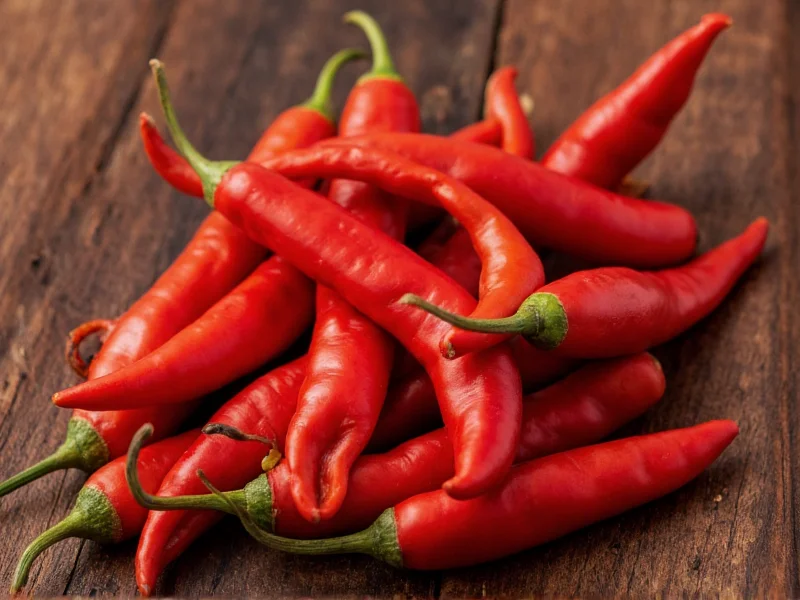Guajillo chiles, one of Mexico's most versatile dried peppers, deliver a distinctive flavor experience that extends far beyond simple heat. Understanding their precise spiciness level helps home cooks and professional chefs alike create balanced dishes without overwhelming diners. This comprehensive guide explores the nuanced heat profile of guajillo chiles, their culinary applications, and how they compare to other common peppers.
Understanding Guajillo Chile Heat Levels
When evaluating how hot are guajillo chiles, the Scoville scale provides the most objective measurement. Guajillo peppers consistently measure between 2,500 and 5,000 Scoville Heat Units. To put this in perspective, they sit at the lower end of medium heat—noticeably warm but rarely overwhelming. The heat builds gradually rather than hitting immediately, allowing their complex flavor to shine through before the warmth registers.
Several factors influence the actual heat experienced when using guajillo chiles:
- Growing conditions: Soil composition and climate affect capsaicin levels
- Preparation method: Toasting and rehydrating can mellow the heat
- Seed and membrane content: Removing these reduces spiciness significantly
- Freshness: Older dried chiles gradually lose potency
Guajillo Heat Compared to Popular Peppers
Understanding where guajillo chiles fall on the guajillo chile Scoville scale relative to other common peppers helps contextualize their heat level. The following comparison shows how guajillo peppers stack up against familiar varieties:
| Pepper Variety | Scoville Heat Units | Heat Comparison to Guajillo |
|---|---|---|
| Guajillo Chile | 2,500–5,000 SHU | Baseline |
| Poblano | 1,000–2,000 SHU | 1.5–2.5x milder |
| Jalapeño | 2,500–8,000 SHU | Slightly hotter on average |
| Serrano | 10,000–23,000 SHU | 2–4.5x hotter |
| Cayenne | 30,000–50,000 SHU | 6–10x hotter |
This comparison reveals why guajillo chiles are considered mild Mexican chiles for cooking—they provide noticeable warmth without dominating a dish. Their heat level makes them accessible to those with moderate spice tolerance while still delivering authentic Mexican flavor.
Beyond Heat: The Flavor Profile of Guajillo Chiles
The true value of guajillo chiles lies in their complex flavor profile that extends far beyond simple spiciness. When properly prepared, they offer:
- Distinctive berry-like notes (often compared to cranberry or raspberry)
- Tangy, slightly acidic undertones
- Subtle tea-like earthiness
- Leather and tobacco hints in darker varieties
- A smooth, rounded mouthfeel that balances the heat
Unlike many hotter peppers that prioritize capsaicin over flavor complexity, guajillo chiles deliver a sophisticated taste experience. This makes them particularly valuable for dishes where are guajillo peppers spicy enough for enchiladas without overpowering other ingredients. Their flavor deepens beautifully when toasted and rehydrated, developing richer notes that form the backbone of many traditional Mexican sauces.
Culinary Applications and Preparation
Professional chefs prize guajillo chiles for their versatility in Mexican cuisine. To maximize their flavor while managing heat levels:
- Remove seeds and membranes: These contain most of the capsaicin. For milder dishes, discard them completely.
- Dry toast lightly: Heat in a dry skillet for 20-30 seconds per side until fragrant but not burnt.
- Rehydrate properly: Soak in hot water (not boiling) for 15-20 minutes until pliable.
- Blend thoroughly: Strain through a fine mesh sieve for smooth sauces.
Traditional applications include:
- Enchilada sauces (particularly red enchilada sauce)
- Moles and adobos
- Marinades for carne asada
- Soups and stews requiring subtle warmth
- Adobo seasoning blends
When substituting in recipes, remember that guajillo chile heat level compared to jalapeno means you'll need to adjust quantities—typically using about 25% more guajillo to achieve similar heat from jalapeños.
Substitutes When Guajillo Chiles Aren't Available
If you're wondering about substitute for guajillo chiles, several options exist, though none perfectly replicate their unique flavor:
- California chiles: Closest match in heat (500–2,500 SHU) but milder with less complexity
- Chiles de árbol: Similar heat range but sharper, more immediate burn
- Ancho chiles: Sweeter and fruitier with comparable mild heat (1,000–2,000 SHU)
- Mixture of paprika and cayenne: For color and heat, but lacks authentic flavor
When substituting, consider both heat level and flavor profile. For dishes where heat is primary concern, adjust quantities based on Scoville ratings. For authentic Mexican flavor, seek specialty stores or online retailers that carry genuine guajillo chiles.
Practical Tips for Cooking with Guajillo Chiles
Maximize your success with guajillo chiles using these professional techniques:
- Store dried chiles in an airtight container in a cool, dark place for up to one year
- Check for mold or excessive brittleness before use—fresh guajillos should have some flexibility
- Wear gloves when handling if sensitive to capsaicin
- Always remove seeds and membranes for milder applications
- Combine with other chiles (like ancho or pasilla) for complex flavor layers
- Balance heat with acidity (lime juice) or sweetness (a touch of sugar)
Understanding these nuances transforms guajillo chiles from a simple spice into a sophisticated culinary tool. Their moderate heat makes them accessible to home cooks while their complex flavor profile satisfies professional chefs seeking authentic Mexican tastes without overwhelming diners.











 浙公网安备
33010002000092号
浙公网安备
33010002000092号 浙B2-20120091-4
浙B2-20120091-4